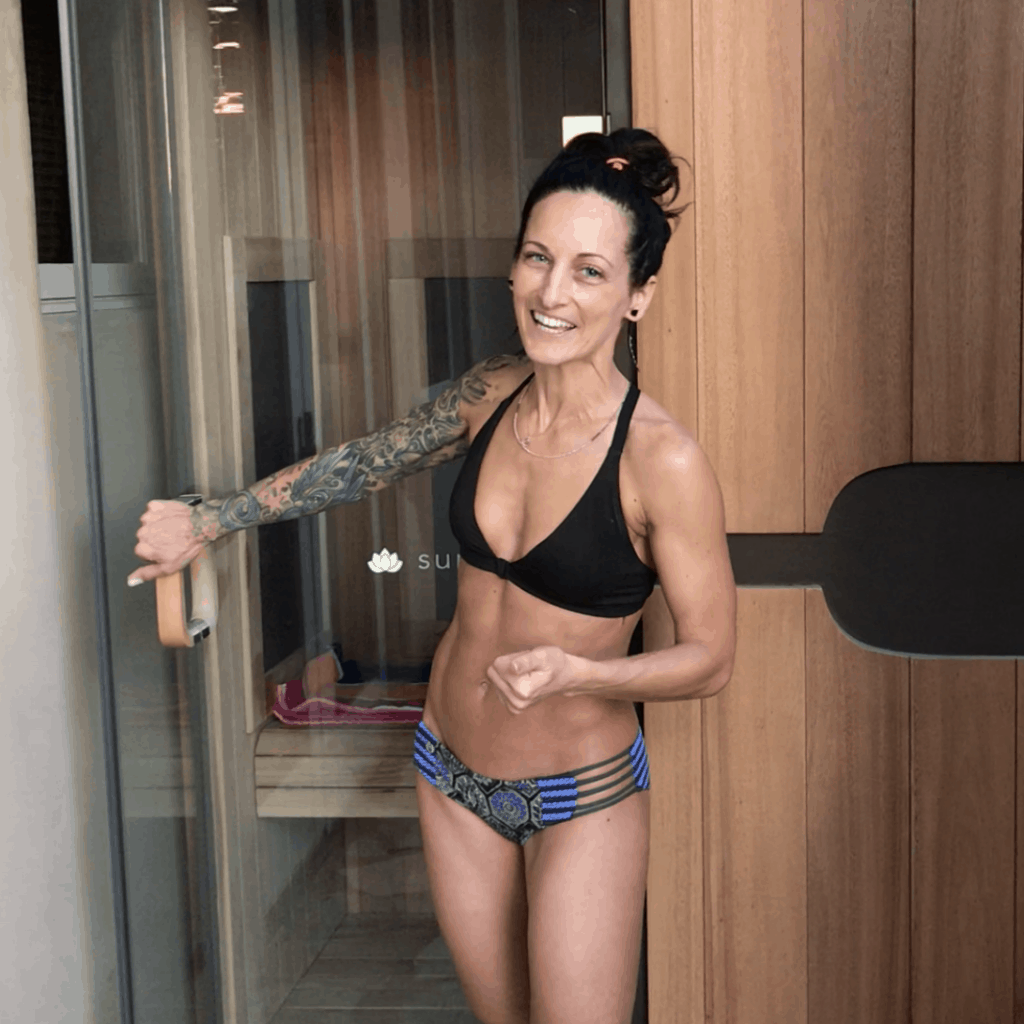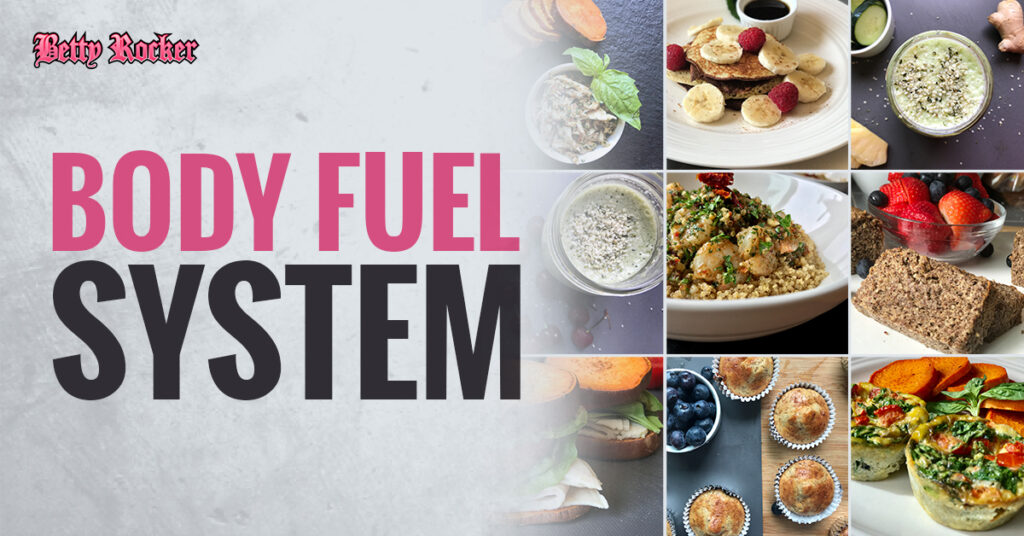
Did you know that your skin is your body’s largest organ?
It makes up about 22 square feet and one seventh of our body weight, making it our first layer of defense against the outside world.
Did you know that it also has three different layers, each with their own job?
The epidermis, dermis and hyper-dermis make up these different layers of your skin and act as a protective barrier, helping us fight off germs, regulate our body temperature and enabling us to feel sensations (1).
Our skin does so much for us, and plays a major role in keeping us healthy!
Glowing skin really does come from the inside out. While it’s impacted by our external environment, it is often a reflection of what’s going on INSIDE the body.
If any part of your body isn’t functioning properly, from your gut (too much junk food) to your brain (too much stress), it can show up on your skin as a way to inform you that something isn’t right.
THE GOOD NEWS IS that you can support your skin (and BONUS, your overall health) with the food you eat, exercising consistently and managing your stress levels.

Since so many people ask me the “secret” to my good skin, this is literally my simple 3-ingredient recipe for what I think really has the biggest impact on the health of your skin (hint, it’s NOT a bunch of products).
3 Ingredients For Glowing Skin
1. “Cleanse” your insides with healthy, whole foods:
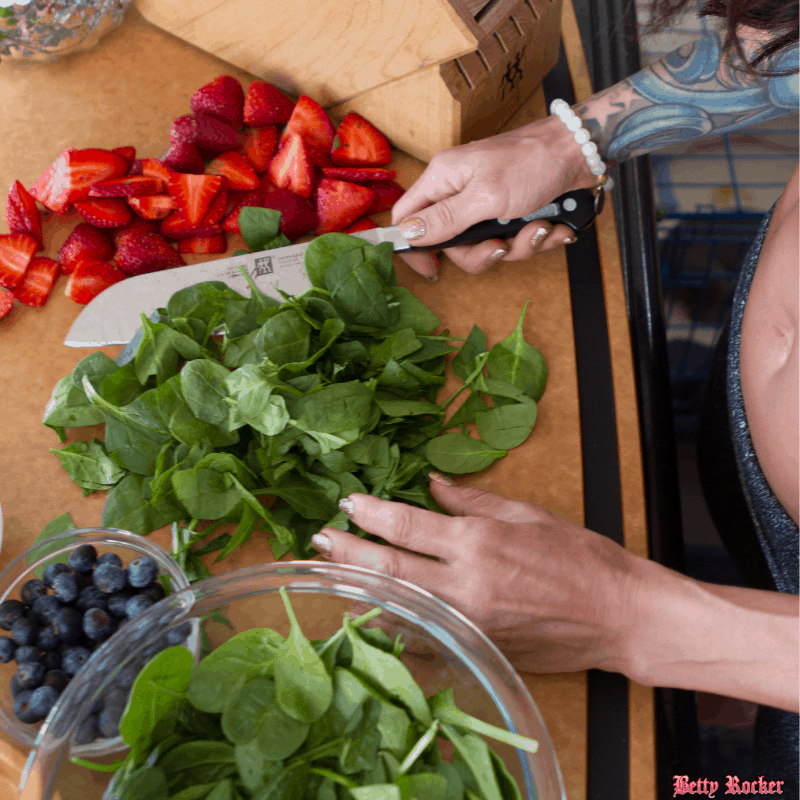
I really noticed my skin clearing up a lot when I started paying attention to foods I ate that caused bloating, made me tired or break out.
Gluten and dairy were the first big 2 I started moderating, and then I was able to get some food sensitivity testing* done to see what other foods might be an issue for me.
I’ve noticed that during times when I didn’t have a lot of variety in my diet, I have developed sensitivities to foods like eggs – but when I stopped eating them every day they stopped showing up in blood panels as irritants.
Everyone is unique and will respond to things differently, I’m just sharing some of my personal experiences as examples so you can be on the lookout for common things you eat too.
Our intestines have an inner ecosystem of bacteria, known as the gut microbiome. This system helps us digest food, control our weight, fight infection and it directly impacts the health of our skin (2).
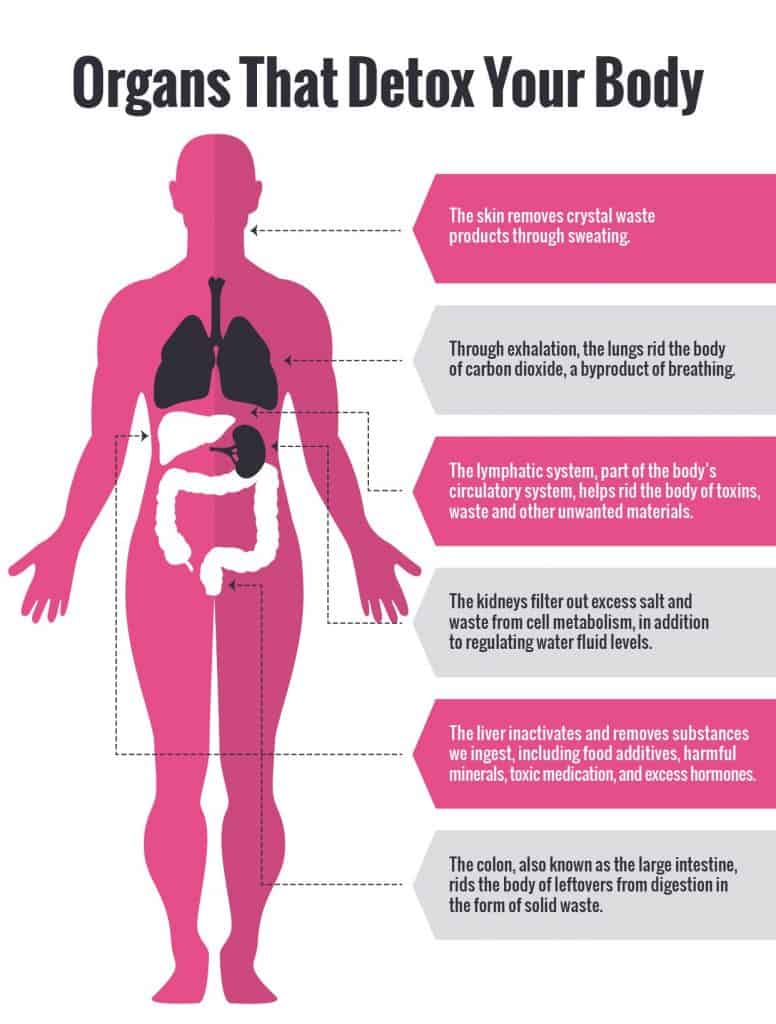
So if our gut isn’t functioning right, most likely we will see that on our skin through acne, rashes and breakouts.
There is a lot to be said about the health of your microbiome, and checking in on it regularly is a great idea. You are unique and you may respond to foods differently than me, or your sister or your daughter.
So test yourself periodically to see what sensitivities you may have – your skin will thank you!
Food sensitivity tests range in accessibility and may show you different results. Here are some I’ve used:
*you’ll need your doctor to order this for you
FOODS TO FOCUS ON:
In general, to get a brighter glow, minimize breakouts and keep your skin supple and smooth, focus on eating:
1: A variety of whole foods
Whole foods from nature contain all the macro (protein, carbohydrates, fats) and micro (vitamins and minerals) nutrients your body needs to thrive. Specifying which ones are optimal for you is important (food sensitivity testing), and so is eating them with enough variety to get the benefit of the different elements they contain.
Rotate your recipes (try one of my eating guides with recipes), rotate your produce seasonally, and supplement with quality supplements from trusted sources as needed.
2: Emphasize healthy fats(3)
Healthy fats help maintain moisture and elasticity in the skin and may also help to defend against overexposure to UV rays (4). They also help your body absorb fat soluble vitamins in plant foods (A, D, E and K) and carotenoids.
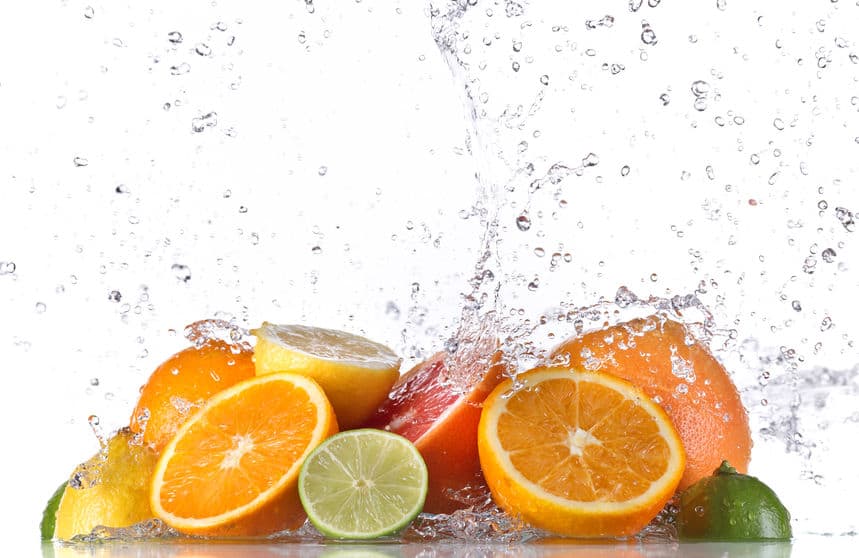
Carotenoids (think fruits and veggies that are bright red, yellow and orange) can actually give dull complexions a boost and result in brighter skin and even potentially increase your skin’s defenses against sunburn by providing a natural SPF (6).
4: Emphasize Vitamin C rich foods (7)
Vitamin C is also important because it plays a key role in forming collagen and also doubles as an antioxidant which can help with anti-aging (8). Research also suggests that vitamin C plays a role in helping to reduce the risk of skin cancer (9).
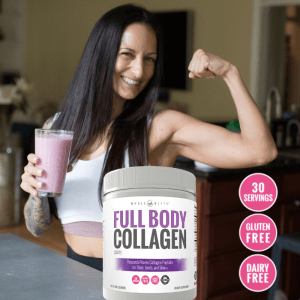
Collagen is another food that plays a vital role in the health of our skin by improving the signs of aging and the appearance of cellulite (11).
It is also one of the building blocks that makes up your skin and muscle tissue and creates the connective tissue in your stomach that “seals and heals” the protective lining of your gut (12).
Adding in a quality vitamin C supplement (or focusing on getting more Vitamin-C rich foods in) when using a collagen supplement is a good idea, and will help your body form more collagen (connective tissue) in the body.
Try any of these delicious recipes…
They are packed with all of the nutrients and antioxidants your body needs to keep your skin healthy, elastic, and youthful:
- Chocolate Raspberry Chia Breakfast Parfait
- Avocado Bean Dip
- Pumpkin White Bean Chili
- Dark Chocolate Raisin Cookie Dough Bites
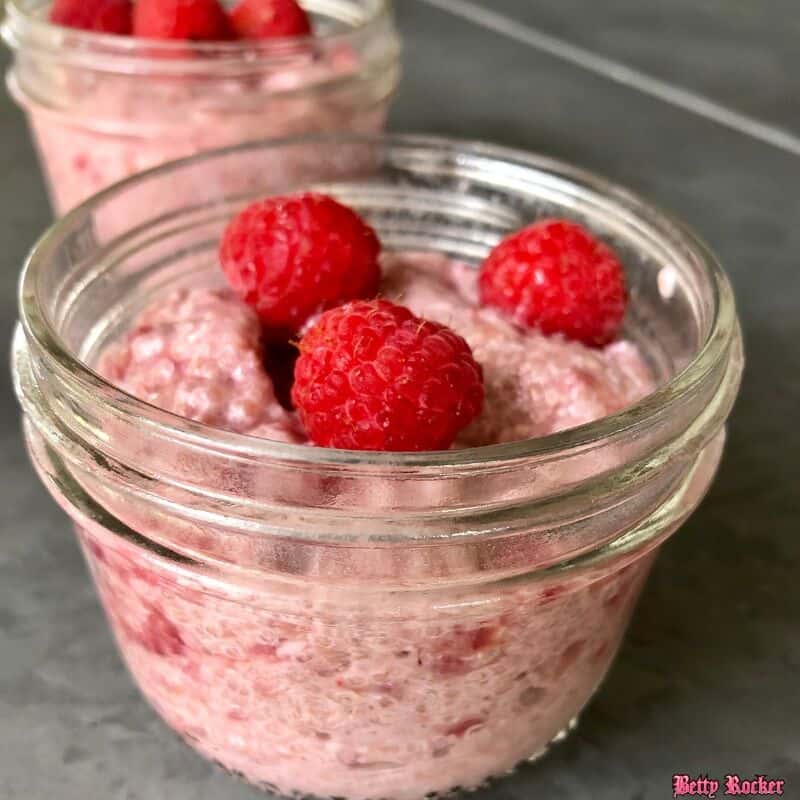
2. SWEAT it out with regular EXERCISE

Physical activity in all forms- cardio, yoga and resistance training– allows fluid to move through your lymphatic system, which is a network of vessels that carry a clear fluid called lymph throughout the body.
This fluid carries cellular waste to the bloodstream which then carries it to the kidneys, colon and lungs for elimination. The better this process works, the less we see these substances show up on our skin, creating issues like blemishes.
Speaking of nutrition, exercise also promotes glowing skin by supporting and improving the health of your gut microbiome (15). Like they say- healthy gut, healthy skin.
FOCUS ON HYDRATION – If you’re sweating it out regularly, it’s especially important to pay attention to staying hydrated. Not only does water ensure your digestive and lymphatic system are lubricated and able to do their jobs, your skin won’t be able to maintain elasticity without proper fluid intake.
BONUS: SAUNA USE – Speaking of sweating it out, I use my infrared sauna. Regular sweat sessions are incredibly beneficial for reducing toxins and wastes through the pores, and the infrared light (nir, mid and far) spectrums in this sauna also penetrates deeply into the cells restoring cell health and improving skin elasticity. You can get more info on sauna use and how to build your own in this post if you’re interested.
It’s a good idea to keep your water bottle with you at all times, and use a water reminder app if you forget to drink water (happens to me all the time).
Ready to sweat it out with these hot workouts and tips?
- Full Body HIIT Circuit
- Cardio Barre
- Sculpt and Strength Supersets
- How to Build Your Own Sauna on a Budget (and why to use one)
3. BREATHE daily to minimize stress

Notice more breakouts than usual or dark circles under your eyes? Check your stress levels (16)!
Skin mast cells are actually activated by stress and in turn produce stress hormones and inflammation which can lead to a cycle of stress induced skin issues (17).
Stress also directly impacts our gut health which as we know has a huge impact on the health and look of our skin (18).
One of the best ways to improve your stress levels and support your skin is through deep breathing and meditation. Both have been shown to reduce your stress levels and calm your mind and body (19), and I’ve been meditating daily since meeting Emily Fletcher and learning her simple Ziva Meditation technique.
Ready to melt stress away and cleanse your mind?
Try this free guided meditation and mindfulness exercise (video guide is right in the post). You can also try taking deep breaths while using essential oils like lavender and eucalyptus to help you relax.
The skin you live in is yours forever Rockstar, so take the time to treat it well. And in return, it will take care of you!

Thanks for being here today! I’ll be looking forward to reading your comments and thoughts below, and feel free to share this post with your friends and family.
Fitness, nutrition, and mindset work together to create the healthiest version of YOU. I wrote the Body Fuel System to put essential information into your hands and give you a wonderful eating plan to practice it all, setting you up for a lifetime of success in your healthy, fit body.
It’s allowed me to eat with joy, get an amazing physique, know my body, know what to do in any situation, try different eating approaches, and really UNDERSTAND why my body would react the way it does to certain foods.
Learn more, and get your complete Body Fuel System today!
- “How does skin work?” Institute for Quality and Efficiency in Health Care. 2006. Web. https://www.ncbi.nlm.nih.gov/books/NBK279255/
- Salem, Iman et al. “The Gut Microbiome as a Major Regulator of the Gut-Skin Axis.” Frontiers in microbiology. 10 Jul. 2018. Web. https://www.ncbi.nlm.nih.gov/pmc/articles/PMC6048199/
- Cho, Soyun. “The Role of Functional Foods in Cutaneous Anti-aging.” Journal of lifestyle medicine. 2014. Web. https://www.ncbi.nlm.nih.gov/pubmed/26064850
- Pilkington SM et al. “Omega-3 polyunsaturated fatty acids: photoprotective macronutrients.” Experimental Dermatology. 2011. Web. https://www.ncbi.nlm.nih.gov/pubmed/21569104
- Stephen ID, et al. “Carotenoid and melanin pigment coloration affect perceived human health” Evolution of Human Behavior. 2011. Web. https://www.sciencedirect.com/science/article/abs/pii/S1090513810001169
- Stahl W, Sies H. “Photoprotection by dietary carotenoids: concept, mechanisms, evidence and future development”. Molecular Nutrition and Food Research. 2012. Web. https://www.ncbi.nlm.nih.gov/pubmed/21953695
- Naiara S.Barbosa, Amer N.Kalaaji. “CAM use in dermatology. Is there a potential role for honey, green tea, and vitamin C?” Complementary Therapies in Clinical Practice. 2013. Web. https://www.ncbi.nlm.nih.gov/pubmed/24439638
- Lorencini M et al. “Active ingredients against human epidermal aging.” Aging Research reviews. 2014. Web. https://www.ncbi.nlm.nih.gov/pubmed/24675046
- Godic A et al. “The role of antioxidants in skin cancer prevention and treatment.” Oxidative Medicine and Cellular Longevity. 2014. Web. https://www.ncbi.nlm.nih.gov/pubmed/24790705
- Borumand Maryam, Sibilla Sara. “Effects of a nutritional supplement containing collagen peptides on skin elasticity, hydration and wrinkles.” Journal of Medical Nutrition & Nutraceuticals.” 2015. Web. http://www.jmnn.org/article.asp?issn=2278-1870;year=2015;volume=4;issue=1;spage=47;epage=53;aulast=Borumand
- Proksch E et al. “Oral supplementation of specific collagen peptides has beneficial effects on human skin physiology: a double-blind, placebo-controlled study.” Skin Pharmacology and Physiology. 2014. Web. https://www.ncbi.nlm.nih.gov/pubmed/23949208
- Koutroubakis IE et al. “Serum laminin and collagen IV in inflammatory bowel disease.”Journal of Clinical Pathology. 2003. Web. https://www.ncbi.nlm.nih.gov/pubmed/14600124
- Margaret E. Sears et al. “Arsenic, Cadmium, Lead, and Mercury in Sweat: A Systematic Review”. Journal of Environmental and Public Health. 2012.Web. https://www.hindawi.com/journals/jeph/2012/184745/
- Silverman, Marni N, and Patricia A Deuster. “Biological mechanisms underlying the role of physical fitness in health and resilience.” Interface focus. 2014. https://www.ncbi.nlm.nih.gov/pmc/articles/PMC4142018/
- Mailing, Lucy J et al. “Exercise and the Gut Microbiome: A Review of the Evidence, Potential Mechanisms, and Implications for Human Health.” Exercise and Sport Sciences Reviews. 2019. Web. https://journals.lww.com/acsm-essr/Fulltext/2019/04000/Exercise_and_the_Gut_Microbiome__A_Review_of_the.4.aspx
- Liana Manolache, Dana Petrescu-Seceleanu. “Stress involvement as trigger factor in different skin conditions.” World Journal of Dermatology. 2013. Web. https://www.wjgnet.com/2218-6190/full/v2/i3/16.htm
- Chen, Ying, and John Lyga. “Brain-skin connection: stress, inflammation and skin aging.” Inflammation & allergy drug targets. 2014. Web. https://www.ncbi.nlm.nih.gov/pmc/articles/PMC4082169/
- Martin, Clair R et al. “The Brain-Gut-Microbiome Axis.” Cellular and molecular gastroenterology and hepatology. 2018. Web. https://www.ncbi.nlm.nih.gov/pmc/articles/PMC6047317/
- Carter, Kirtigandha Salwe, and Robert Carter 3rd. “Breath-based meditation: A mechanism to restore the physiological and cognitive reserves for optimal human performance.” World journal of clinical cases. 2016.Web. https://www.ncbi.nlm.nih.gov/pmc/articles/PMC4832119/
